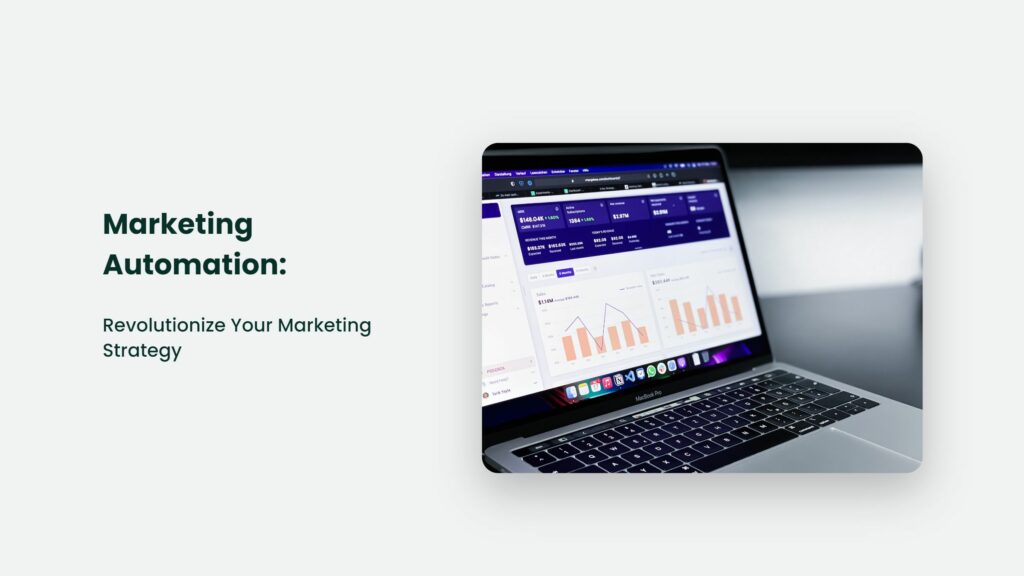Have you ever felt like a hamster on a wheel, endlessly sending out emails to your leads? Well, it’s time to hop off that wheel and embrace the world of automation. It’s like having a personal assistant without bad breath and awkward small talk. You can sit back, relax, and let the robots do your work. So grab a snack, sit back, and explore the magical world of marketing automation.

Definition
Marketing automation software uses technology to automate repetitive marketing tasks like email campaigns, social media posts, and lead nurturing. It enables businesses to streamline their marketing processes, save time and resources, and provide personalized, targeted messaging to their audience.
Importance of Automation in today’s digital world
Marketing automation is an essential component of any successful digital marketing automation strategy. In today’s digital world, where customers are inundated with information from various sources, automation can help businesses deliver personalized and relevant content to their customers at the right time, leading to increased engagement, conversions, and customer loyalty.
Here are some of the reasons why automation is essential in today’s digital world:
- Saves time and increases efficiency: Marketing automation helps to automate repetitive and time-consuming tasks, such as email marketing, social media scheduling, and lead nurturing, freeing up time for marketers to focus on more strategic initiatives.
- Improves customer experience: By providing personalized and relevant content to customers at the right time, marketing automation can help to improve the overall customer experience, leading to higher engagement and customer satisfaction.
- Increases ROI: By automating lead generation and nurturing processes, marketing automation can help businesses to increase their conversion rates and ultimately generate more revenue.
- Provides valuable data and insights: Automation platforms typically offer detailed analytics and reporting, which can help businesses to understand their customers better and optimize their marketing strategies.
- Enables multichannel marketing: With marketing automation, businesses can easily manage and coordinate their marketing campaigns across multiple channels, such as email, social media, and SMS, ensuring a consistent message and brand experience for their customers.
Furthermore, the choice of the right marketing automation software is crucial. Opting for an all-in-one solution like Adplorer not only streamlines the automation process but also equips businesses with a comprehensive suite of tools for effectively managing various campaigns of digital marketing. By utilizing all-in-one marketing automation platforms, businesses can further enhance their marketing efforts and harness the full potential of automation.
Overall, marketing automation is a critical tool for businesses looking to stay competitive in today’s digital landscape, helping them deliver personalized and relevant content to their customers, increase efficiency, and ultimately drive more revenue.
How to implement Marketing Automation?
Here are some steps to implement automation:
- Define your marketing automation goals: Determine the specific goals you want to achieve with automation. This could include lead generation, nurturing, increasing conversions, or improving customer retention.
- Choose the right marketing automation platform: Research and compare different marketing automation platforms to find the one that best meets your needs and budget.
- Develop buyer personas: Create detailed buyer personas that represent your ideal customers. This will help you create more targeted and effective marketing campaigns.
- Map out your customer journey: Map out the different stages of your customer journey and identify opportunities to use automation to deliver personalized content and messaging.
- Set up lead capture forms: Create lead capture forms on your website and landing pages to collect contact information from potential customers.
- Create email campaigns: Develop automated email campaigns that deliver relevant content to your leads at different customer journey stages.
- Set up lead nurturing workflows: Create information-enabling workflows that automatically send relevant content to charges based on their behaviour and interests.
- Integrate with other systems: Integrate your marketing automation platform with other methods, such as your CRM, to ensure that all customer data is synced and up-to-date.
- Monitor and analyze performance: Use your automation platform’s analytics and reporting features to track your campaigns’ performance and identify improvement areas.
- Continuously optimize and refine: Use the insights from your performance monitoring to make adjustments and improvements to your marketing automation campaigns on an ongoing basis.
By following these steps, you can successfully implement marketing automation and achieve your marketing goals more efficiently and effectively.
Real-Life examples of successful Marketing Automation
Here are a few examples of companies that have implemented automation and seen positive results:
- The Coca-Cola Company: Coca-Cola uses automation to deliver personalized content and messaging to customers across multiple channels. By doing so, they have seen a 42% increase in sales and a 23% increase in customer retention.
- The Adecco Group: Adecco implemented marketing automation to streamline their lead generation and nurturing processes. As a result, they saw a 25% increase in lead generation and a 400% increase in website engagement.
- HubSpot: HubSpot is a leading marketing automation platform that has seen tremendous success using its platform. By leveraging automation for lead generation, nurturing, and scoring, they have achieved a 20% increase in revenue and a 50% increase in lead-to-customer conversion rates.
- Lenovo: The global technology company Lenovo implemented marketing automation to improve its lead generation and nurturing efforts. By using personalized content and targeted messaging, they achieved a 20% increase in conversion rates and a 2x increase in qualified leads.
- Pizza Hut: Pizza Hut implemented marketing automation to improve its customer experience and drive more sales. Using targeted messaging and personalized promotions, they saw a 55% increase in online orders and a 163% increase in mobile orders.
These examples demonstrate how companies of all sizes and industries can benefit from implementing automation to achieve their marketing goals and drive business results.
Frequently Asked Questions
What is the major obstacle to marketing automation?
Finding the right marketing automation platform is a significant obstacle for many marketers. 45.9% of marketers who don’t use automation are struggling to find a platform with the required capabilities, according to a HubSpot Blog research report. It’s like searching for a magical unicorn that can do it all.
However, numerous automation tools can help you achieve your goals. By conducting thorough research, comparing your options, and finding the best platform for your needs, you can overcome this obstacle and benefit from automation.
What is the most common use of applied marketing automation?
Marketing automation allows the creation of personalized, relevant content for your prospects and customers. It’s like having your own personal army of marketing robots that can help with email marketing, behavioural targeting, lead prioritization, and personalized advertising.
This can save time, improve efficiency and drive results. Marketing automation is a game-changer for any business looking to scale up and compete in today’s competitive digital landscape.
What is the reason for the failure of marketing automation?
Marketing automation fails commonly due to neglecting the quality of content. Automating processes is possible, but the content needs to be engaging and relevant to the audience.
Despite well-set automation, poor content quality will not convert as many people as desired. Creating high-quality, relevant, engaging content is crucial for resonating with your target audience and driving desired actions.
Final thoughts
In conclusion, if you want to be a marketing superhero, you must have a secret weapon. And that secret weapon is marketing automation. By automating your marketing processes, you’ll be able to save time, increase efficiency, and deliver personalized content to your customers like a boss.
So, don’t be a marketing villain and miss out on the benefits of automation. Instead, be a marketing hero and take your business to the next level.




